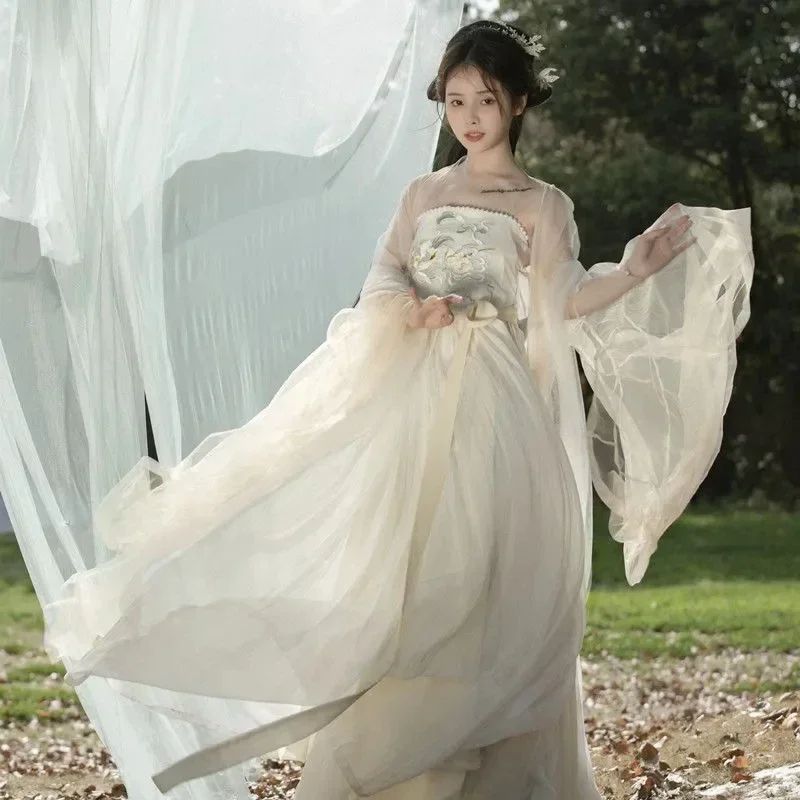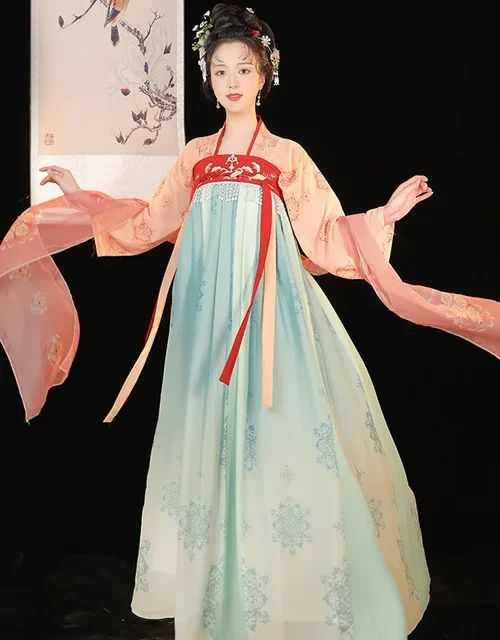The Evolution of Tang Dynasty Hanfu: From Practicality to Elegance
A Symbol of Grace and Power in Ancient China
The Tang Dynasty (618-907 CE) marked a golden age in Chinese history, renowned for its cultural achievements and artistic brilliance. Among its many contributions, the Tang Dynasty left an enduring legacy in the form of hanfu, the traditional clothing of the era. Hanfu evolved from its humble origins as practical attire to become a symbol of grace, elegance, and power.

Functional Origins
Initially, hanfu served a primarily functional purpose. Its loose-fitting robes and wide sleeves allowed for freedom of movement, making it suitable for everyday activities and strenuous tasks. However, as the Tang Dynasty flourished, hanfu underwent a transformation, becoming more elaborate and ornate, reflecting the growing wealth and sophistication of society.
Cultural Exchange and Influence
The Tang Dynasty witnessed a surge in cultural exchange with neighboring regions, influencing the development of hanfu. Persian and Central Asian motifs, such as floral patterns and vibrant colors, were incorporated into the designs. The use of silk, a luxurious fabric, became widespread, adding to the garments’ elegance and drape.
Symbol of Social Status
Hanfu also became a symbol of social status. The ruling class and wealthy elite adopted elaborate and opulent hanfu, adorned with intricate embroidery, precious stones, and gold thread. In contrast, common people wore simpler and more practical versions, reinforcing the hierarchical structure of Tang society.
Cultural and Political Significance
Beyond its aesthetic appeal, hanfu held significant cultural and political meaning. It was worn during important ceremonies and rituals, representing the wearer’s connection to tradition and the state. The emperor, as the supreme ruler, wore the most elaborate and majestic hanfu, symbolizing his authority and divine mandate.
Artistic Expression
The Tang Dynasty’s emphasis on beauty and refinement extended to all aspects of life, including fashion. Hanfu became a canvas for artistic expression, showcasing the creativity and skill of Tang artisans. The garments were often adorned with intricate patterns, calligraphy, and paintings, reflecting the era’s love of nature and the pursuit of harmony.
Enduring Legacy
The legacy of Tang Dynasty hanfu continues to inspire contemporary fashion designers and enthusiasts. Its graceful lines, vibrant colors, and intricate designs have become synonymous with Chinese culture and heritage. Today, hanfu is not only a historical artifact but also a symbol of national pride and cultural identity.
The Cultural Significance of Hanfu in Tang Dynasty China
A Symbol of Grace and Power
During the Tang Dynasty (618-907 CE), hanfu, the traditional Chinese attire, reached its zenith of elegance and sophistication. It became a potent symbol of grace, power, and cultural identity.

Cosmopolitan Design
Hanfu’s design reflected the Tang Dynasty’s cosmopolitan spirit, incorporating elements from various cultures, including Central Asia and Persia. The garments were characterized by flowing lines, vibrant colors, and intricate embroidery. Women’s hanfu featured long, wide sleeves and skirts, while men’s hanfu consisted of loose robes and trousers.
Symbolic Colors and Fabrics
The choice of fabrics and colors was equally significant. Silk, a luxurious material, was widely used in hanfu. Its shimmering texture and vibrant hues added to the garments’ allure. Colors held symbolic meanings: red represented auspiciousness, yellow symbolized imperial power, and green denoted prosperity.
Social Hierarchy
Hanfu was not merely a fashion statement; it also played a crucial role in social hierarchy. The style, color, and ornamentation of one’s hanfu indicated their social status. Elaborate hanfu with intricate embroidery was reserved for the elite, while simpler garments were worn by commoners.
Cultural Exchange
The Tang Dynasty was a period of great cultural exchange. Hanfu became a symbol of China’s cultural influence abroad. Japanese and Korean envoys to the Tang court were so impressed by hanfu that they adopted it into their own cultures.
Practical Functions
In addition to its aesthetic and social significance, hanfu also had practical functions. The loose-fitting garments allowed for freedom of movement, making them suitable for both everyday activities and formal occasions. The wide sleeves provided ample space for carrying objects, while the long skirts offered protection from the elements.
Enduring Legacy
The Tang Dynasty’s hanfu has left an enduring legacy on Chinese culture. It remains a symbol of grace, power, and cultural identity. In recent years, there has been a resurgence of interest in hanfu, with many choosing to wear it for special occasions or as a way to connect with their cultural heritage.
The Influence of Tang Dynasty Hanfu on Modern Fashion
A Symbol of Grace and Power
The Tang Dynasty (618-907 CE) marked a golden age in Chinese history, renowned for its cultural achievements and artistic brilliance. Among its many contributions, the Tang Dynasty left an enduring legacy in the form of hanfu, the traditional clothing of the era. Hanfu embodied the grace, power, and sophistication that characterized Tang society.

Social Status and Identity
Hanfu was more than just clothing; it was a symbol of social status and cultural identity. The elaborate designs and intricate embroidery reflected the wearer’s wealth and position. The flowing robes and wide sleeves allowed for freedom of movement, emphasizing the elegance and poise of the Tang people.
Cultural Exchange
The Tang Dynasty was a period of great cultural exchange, and hanfu absorbed influences from various regions. Persian and Central Asian motifs added a touch of exoticism to the traditional Chinese aesthetic, resulting in a unique and cosmopolitan style.
Political and Military Roles
Hanfu also played a significant role in political and military spheres. Emperors and officials wore elaborate hanfu to display their authority and inspire awe in their subjects. Soldiers donned hanfu modified for combat, providing both protection and a sense of unity and purpose.
Resurgence in Modern Fashion
The influence of Tang Dynasty hanfu extends beyond its time. In modern China, there has been a resurgence of interest in traditional culture, and hanfu has become a symbol of national pride and cultural heritage. Fashion designers draw inspiration from hanfu, incorporating its elements into contemporary designs.
Enduring Inspiration
The flowing silhouettes, vibrant colors, and intricate embroidery of Tang Dynasty hanfu continue to captivate and inspire. It is a testament to the enduring legacy of the Tang Dynasty and the timeless beauty of Chinese traditional clothing. As a symbol of grace and power, hanfu remains an iconic representation of one of the most influential periods in Chinese history.
